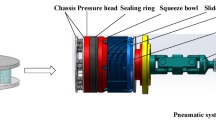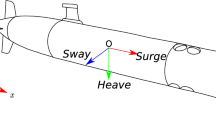Abstract
The pipe isolation tool (PIT) demonstrates remarkable advantages in safety and efficiency compared with traditional plugging devices. However, its utilization in plugging operations is limited by the operation duration. In addition, the existing energy recovery system has low energy saving efficiency. In this paper, a real-time control energy-saving system of the PIT was designed based on a reinforcement learning algorithm. First, an experimental device for energy-saving was designed. Secondly, the energy distribution scheme of a hydraulic pump and accumulator based on experimental data was proposed. Finally, the reinforcement learning algorithm was used to adjust the opening of the hydraulic pump and the accumulator valves in real time during the plugging process to improving energy saving efficiency. The results verify that the energy saving efficiency of the PIT control system based on reinforcement learning could reach 23.71%, which satisfies the objectives of energy-saving and environmental applicability.














Similar content being viewed by others
References
Chiriboga J, T. M. W. L. (2002). Input-output feedback linearization control of a load-sensing hydraulic servo system. In: Proceedings of International Conference on control applications. IEEE.
Dey, P. K. (2001). A risk-based model for inspection and maintenance of cross-country petroleum pipeline. Journal of Quality in Maintenance Engineering, 7(1), 25–43.
Edd Tveit, J. A. (2000). Remote controlled (Tether-Less) high pressure isolation system. In: SPE Asia Pacific Oil and Gas Conference and exhibition. Brisbane, Australia
El-Abbasy, M. S., Senouci, A., et al. (2014). Artificial neural network models for predicting condition of offshore oil and gas pipelines. Automation in Construction, 45, 50–65.
Hao, Y., Quan, L., et al. (2018). Potential energy directly conversion and utilization methods used for heavy duty lifting machinery. Energy, 155, 242–251.
Hendrix, M. H. W., Jsseldijk, H. P. I., et al. (2018). Experiments and modeling of by-pass pigging under low-pressure conditions. Journal of Process Control, 71, 1–13.
Kong, Z., Zou, Y., et al. (2017). Implementation of real-time energy management strategy based on reinforcement learning for hybrid electric vehicles and simulation validation. PLoS ONE, 12(7), e0180491.
Li, L., Huang, H., et al. (2016). An energy-saving method to solve the mismatch between installed and demanded power in hydraulic press. Journal of Cleaner Production, 139, 636–645.
Li, L., Huang, H., et al. (2017). Analysis of a novel energy-efficient system with double-actuator for hydraulic press. Mechatronics, 47, 77–87.
Liang, Z., He, H., et al. (2017). Speed simulation of bypass hole PIG with a brake unit in liquid pipe. Journal of Natural Gas Science and Engineering, 42, 40–47.
Mirshamsi, M., & Rafeeyan, M. (2019). Speed control of inspection pig in gas pipelines using sliding mode control. Journal of Process Control, 77, 134–140.
Nguyen, T. T., & Kim, D. K. et al. (2001). Dynamic modeling and its analysis for PIG flow through curved section in natural gas pipeline. In: IEEE.
Qi, X., Luo, Y., et al. (2019). Deep reinforcement learning enabled self-learning control for energy efficient driving. Transportation Research Part C: Emerging Technologies, 99, 67–81.
Shen, P., Zhao, Z., et al. (2018). Optimal energy management strategy for a plug-in hybrid electric commercial vehicle based on velocity prediction. Energy, 155, 838–852.
Tolmasquim, S. T., & Nieckele, A. O. (2008). Design and control of pig operations through pipelines. Journal of Petroleum Science and Engineering, 62(3–4), 102–110.
Tveit, E., Aleksandersen, J. (2000). Remote Controlled (Tether-Less) high pressure isolation System. In: SPE Asia Pacific Oil and Gas Conference and Exhibition. Brisbane, Australia, Society of Petroleum Engineers: 8.
Wu, J., He, H., et al. (2018). Continuous reinforcement learning of energy management with deep Q network for a power split hybrid electric bus. Applied Energy, 222, 799–811.
Wu, T., & Zhao, H. (2019). An energy-saving and velocity-tracking control design for the pipe isolation tool. Advances in Mechanical Engineering, 11(4), 168781401984594.
Xiang, C., Ding, F., et al. (2017). Energy management of a dual-mode power-split hybrid electric vehicle based on velocity prediction and nonlinear model predictive control. Applied Energy, 189, 640–653.
Xiangjing, L., & Wanrong, W. (2018). Control strategy of energy saving for power system in hydraulic surface drilling rig. Journal of the Brazilian Society of Mechanical Sciences and Engineering, 40(6), 282. https://doi.org/10.1007/s40430-018-1211-8
Zhu, X., Zhang, S., et al. (2014). Experimental study on dynamics of rotatable bypass-valve in speed control pig in gas pipeline. Measurement, 47, 686–692.
Acknowledgements
This work was financially supported by the National Natural Science Foundation of China (Grant No. 51575528).
Author information
Authors and Affiliations
Corresponding author
Additional information
Publisher's Note
Springer Nature remains neutral with regard to jurisdictional claims in published maps and institutional affiliations.
Rights and permissions
About this article
Cite this article
Wu, T., Zhao, H., Gao, B. et al. Energy-Saving for a Velocity Control System of a Pipe Isolation Tool Based on a Reinforcement Learning Method. Int. J. of Precis. Eng. and Manuf.-Green Tech. 9, 225–240 (2022). https://doi.org/10.1007/s40684-021-00309-8
Received:
Revised:
Accepted:
Published:
Issue Date:
DOI: https://doi.org/10.1007/s40684-021-00309-8




